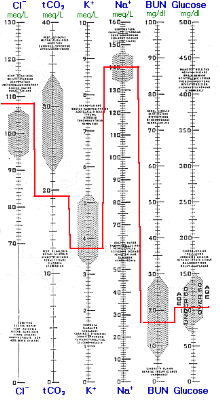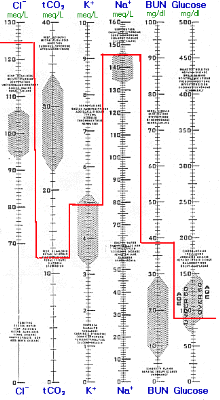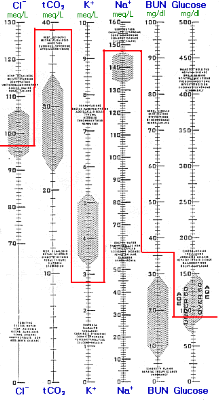Though Blood gas results completely reveal the nature of acid/base disturbances, the 6-7 panel chemistry results provide more pertinent information about electrolyte and fluid imbalances.
Renal Tubular Acidosis:

RTA is a rare condition caused by a genetic defect in H+ secretion, and consequently deficient HCO3- reabsorption and formation. The condition represents a simple example of metabolic acidosis not complicated by fluid and electrolyte disturbances. Since the condition is chronic, respiratory compensation is complete as possible. Chloride is increased to the same extent that HCO3 - is decreased and the anion gap is normal. Serum K+ is normal despite the K+/H+ shift because of deficient H+ counter secretion and consequent increased renal K+ countersecretion associated with normal aldosterone-stimulated Na+ reabsorption. Potassium deficiency and hypokalemia occurs if potassium intake is not sufficient to counteract the increased renal potassium loss.
Metabolic Acidosis from Diarrhea:

Unabsorbed GI secretions represent the potential loss of up to 6 liters of fluid per day. The fluid is electrolyte poor, with respect to serum, except for HCO3 - which is lost in greater amounts than is acid. Persistent diarrhea causes serious dehydration and acidosis. The kidneys release renin in response to the hypovolemia and the in-creased formation of angiotensin causes decreased renal blood flow and increased adrenal cortical elaboration of aldosterone. The consequent increased distal tubule Na+ reabsorption causes increased H+ and K+ secretion, with relatively more H+ than K+ secretion because of the acidosis. Despite the intracellular H+/K+ shift, the serum potassium concentration is normal because of the absolute increase in renal K+ secretion. The loss of Na+ poor fluid and increased renal Na+ reab-sorption results in hypernatremia and hyperosmolality causing in-creased pituitary elaboration of ADH. Increased renal water reabsorp-tion cannot improve the hypovolemia without intestinal absorption of ingested water so that hypernatremia and hyperosmolality persist. The decreased GFR, from decreased renal blood flow, causes corresponding increases in serum urea and creatinine concentrations. Serum urea is additionally increased because of increased renal water reabsorption so that the serum urea/creatinine ratio is increased. Total GI secretions are not so hypoosmolar as gastric fluid so there is less transfer of intracellular fluid in diarrhea than in vomiting and the quantity of lost fluid is greater in diarrhea.
Metabolic Alkalosis from Vomiting:

Gastric fluid contains a high content of acid and potassium and the fluid volume is substantial. Persistent vomiting results in alkalosis, hypokalemia and dehydration. The vomiting does not permit replacement of the lost fluid and electrolytes. The kidneys release renin in response to the hypovolemia and the increased formation of angiotensin causes decreased renal blood flow and increased aldosterone-stimulated renal Na+ reabsorption. The increased Na+ reabsorption is limited by the hypokalemia and alkalemia, but that which does occur is associated with H+ and K+ secretion further worsening the alkalemia and hypokalemia. The loss of the hypoosmolar, sodium poor gastric fluid, along with increased renal Na+ reabsorption, results in hypernatremia, but not markedly so because of transfer of intracellular fluid. The hyperosmolality stimulates pituitary release of ADH and maximum renal water reabsorption. Increased water reabsorption, without water ingestion, does not improve the hypovolemia and hypernatremia, but limits renal fluid loss as does decreased GFR from decreased renal blood flow. Serum concentrations of urea and creatinine are increased in proportion to the decreased GFR and urea is additionally increased because of increased water reabsorption so that the serum urea/creatinine ratio is increased.
last updated: March 8, 2016